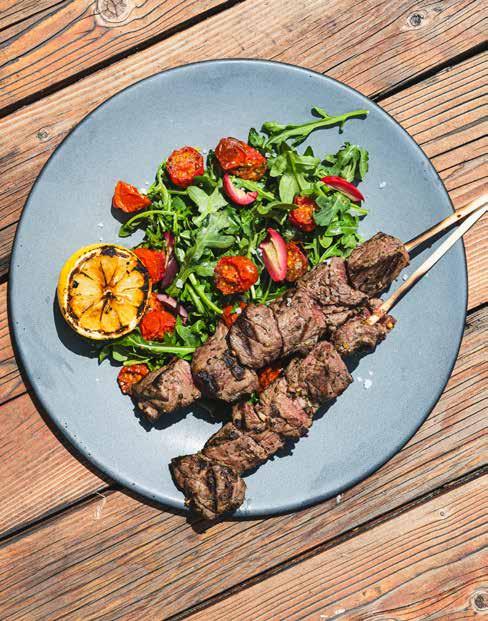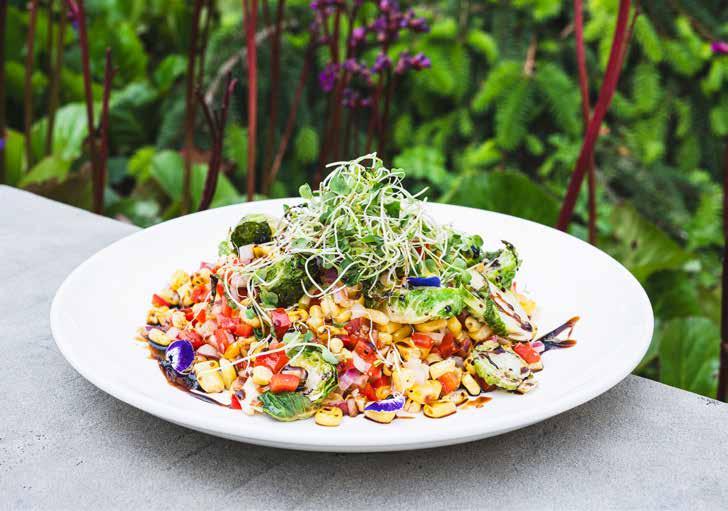
9 minute read
Bite into Summer
BY KEANE STRAUB PHOTOS BY DONG KIM
When it comes to cooking – and eating – in the summertime, there’s one thing we likely all agree on: less is more. Less time prepping, less time cooking, and lighter dishes that are designed for grazing or devouring in one bite as you mingle at outdoor gatherings.

“My happy place is creating delicious food that can be shared with my family and friends,” says Chef Jacqui Woodward of Red Deer’s Cronquist Tea House. “We have a pretty limited menu, but the rotating desserts and high tea treats are my favourite.” She enjoys the creative aspect of the job, and the freedom to use seasonal ingredients in memorable ways, like chocolate strawberry mousse cheesecake and peanut butter pie.
Her best trick in the kitchen is keeping things simple. “You don’t need to make crazy elaborate dishes for it to be delicious,” she says. “Pick one ingredient and add a couple more to complement and elevate the star of the plate.”
Keeping it simple doesn’t mean you can’t be adventurous. “I like to play with different flavours and ingredients,” Woodward says. Her recipe for Whipped Goat Cheese and Mango Dip was created when a bride and groom requested a dip bar for one of their stations at their wedding reception. “I asked the bride for two flavours and the groom for three. Luckily, they all worked well together!”
From there, the dip was created and is now one of Chef Jacqui’s favourites for potlucks and backyard barbecues.
What we don’t cut back on, however, is flavour and variety. We asked chefs at some of Alberta’s most popular tourist destinations to give us their best bites that are easy to recreate and versatile. From dips to sticks, bannock and Brussels sprouts, you’re going to circle back for seconds (and probably thirds too!).
“Let your cheese warm up a bit before whipping,” she adds. “And if you’re not a fan of goat cheese, you can substitute feta.” Lastly, get creative with the toppings, anything from fresh fruit to sautéed bacon and onions.
Whipped Goat Cheese and Mango Dip
Serves 4
165 g cream cheese
165 g goat cheese
1 clove garlic chopped
Pinch salt
2 Tbs (30 mL) olive oil
½ cup dried apricots, diced
1 jar mango chutney
Roasted pistachios
Drizzle honey
1. In a food processor or stand mixer, mix cream cheese, goat cheese, garlic, salt, and olive oil until smooth and fluffy. Add apricots, and mix.
2. Transfer mixture to a serving dish of your choice.
3. Top your cheese mixture with about ¾ jar of mango chutney. Drizzle with honey and finish with roasted pistachios.
4. Serve with your favourite vegetables, breads, and crackers.

“I’ve always loved working with my hands and creating experiences that bring people joy, with some of my fondest memories being in the kitchen, spending time with my Mama,” says Chef Tobias Larcher. “As much as I loved being outside, I was just as happy learning, helping, and creating alongside her in the kitchen. Those early moments are a big reason why I’m a chef today.”
The Director of Culinary Services at Calgary’s Heritage Park, Chef Tobi (as most people call him) is surrounded by a multitude of menu items spread out over 14 food outlets. Choosing just one favourite is no easy task. “If I had to choose, I’d say the Millarville Ranchers Steak Taco at the Selkirk Restaurant. The fresh bannock is made in-house at the Alberta Bakery, and the chimichurri aioli features herbs straight from our kitchen garden.”
His garden at home, as well as his family, are the inspirations for his recipe Garden Herb Beef Skewers. “These are my daughters’ favourite,” he says. “My wife and I make them a lot throughout the summer, using fresh ingredients from our garden. Plus, they’re perfect to take on camping trips.”
Keep food prep straightforward and manageable, he says. “With a bit of planning, most of the hard work can be done in advance. This way, you get to spend less time in the kitchen and more time enjoying good company.”

Garden Herb Beef Skewers with Roasted Tomato and Arugula Salad
Serves 2
3 Tbs (45 mL) olive oil
1 medium lemon, juiced and zested
2-3 cloves garlic
½ bunch fresh dill
2 stalks fresh oregano
1 tsp onion powder
1 tsp ground cumin
1 tsp ground coriander
½ tsp chili flakes
½ tsp ground black pepper
2 tsp salt
225 g striploin or flank steak, cubed
1. In a bowl, combine olive oil, lemon juice and zest, garlic, and spices.
2. Add beef and marinate for at least an hour.
3. Thread the marinated beef onto skewers and grill for 8–10 minutes, turning occasionally, until perfectly seared. Let rest before serving.
Roasted Tomato–Arugula Salad
225 g cherry tomatoes
1 Tbs (15 mL) olive oil
To taste salt and pepper
4 cups arugula
1 cup of kalamata olives
1–2 Tbs toasted nuts (optional)
Dressing:
2 Tbs (30 mL) extra virgin olive oil
1 Tbs (15 mL) lemon juice
To taste salt and pepper
1. Roast tomatoes at 400° F for 15–20 minutes.
2. Toss arugula with tomatoes, olives, and nuts.
3. Mix dressing ingredients well, and drizzle over salad. Serve immediately.

Chef Sa Hyun Kim’s style of cooking is rooted in his experiences. His mother’s influence helped him develop a deep respect for tradition but, “At the same time, I’m always inspired by travel, the people I meet and their stories, and the authenticity of different cuisines and their techniques.”
As Executive Chef at Fort Edmonton Park, everyone calls him “Chef Sam”. Here, menus reflect his style of balancing between traditions. “One of my favourite dishes is braised duck on bannock with berry compote. It celebrates heritage while integrating modern ingredients with an edge of culinary creativity.”
“In Indigenous communities, bannock is a symbol of strength and creativity. Slow braised duck is very rich, tender, and full of flavour, and is appreciated in many cultures including my own. Using local berries like Saskatoons for the compote ties it back to the land and the seasons.” The result truly is a story on the plate.
Chef Sam suggests collecting the rendered duck fat to baste the duck or use in the bannock. “Don’t overmix the bannock,” he adds. “Mix until the dough comes together, use a hot pan with shallow oil and serve right away.”
Braised Duck on Bannock with Berry Compote
Serves 2
2 duck legs, bone-in, skin on
1 tsp salt
1/8 tsp pepper
½ tsp roasted paprika powder
1 tsp onion powder
1 tsp garlic powder
1. Mix all dry ingredients together thoroughly.
2. Apply dry rub over duck legs and place into a well-greased pan.
3. Bake at 300º F for 2 hours, then increase to 375º F for 10 more minutes
- it helps the skin brown up and crisp beautifully.
4. Once an internal temperature of 165º F has been achieved, remove from oven and rest for 25 minutes. Shred the duck meat.

Tip: For the duck, go low and slow. It makes for a much more tender duck. Duck has rich fat, so be sure to collect the rendered fat to baste your duck or reserve the fat to use in your bannock or for other recipes. Use chicken if needed and just adjust the cooking time.
Bannock
3 cups all-purpose flour
2 Tbs baking powder
1 tsp salt
¼ cup sugar
½ cup margarine or shortening
Cold water
1. Add all dry ingredients to a bowl.
2. Cut into the mixture half a cup of margarine or shortening.
3. Add enough cold water to make a dry dough.
4. Place in a greased frying pan and bake in 400º F oven for 30 minutes.
Tip: Don’t overmix the bannock. Mix until dough comes together. Use a hot pan, with shallow oil (you can use the duck fat if you wish) and serve right away.
Berry Compote
2 cups your choice of berries, fresh or frozen
3 Tbs (45 mL) water
¼ cup sugar
2 Tbs (30 mL) lemon juice
1. Combine 1 cup of berries, water, sugar, and lemon juice in a small saucepan. Cook over medium heat about 10 minutes until berries have broken down and all ingredients are smooth and incorporated.
2. Add the rest of the berries and cook for 8 minutes more, stirring frequently. Serve warm.

Since he started cooking, Chef Krish Nair says he’s evolved as an environmental chef promoting food sustainability and resilience. “I grew up surrounded by the vibrant flavours of my family’s farm that have taught me to be grateful for everything that I have.” Passionate about exploring ingredients, he says he’s fortunate to be surrounded by mentors and chefs, learning invaluable lessons along the way.
As Corporate Chef at the Wilder Institute/Calgary Zoo, he creates dishes that emphasize local produce and a commitment to sustainability. “We work closely with local farmers and ranchers as well as our own horticulture team to source our ingredients.” The result are dishes such as his favourite Smoked Alberta Beef Brisket with Saskatoon Berry Demi-Glace, and the Vegan Watermelon Poke Bowl.
His recipe for Charred Brussels Sprouts Succotash is another dish that highlights locally sourced, sustainable ingredients. “This is a simple, fresh dish that celebrates the beauty of vegetables,” he explains. It’s easy to make, and pairs with just about anything you can think of, which makes it perfect for any outdoor affair.
“A recipe is just a script,” adds Chef Krish. “The magic happens when you fall in love with the process. When you cook from the heart, you’ll naturally start adding your own favourite ingredients, making the dish uniquely yours. That emotional connection is the most valuable and irreplaceable ingredient in any recipe.”
Charred Brussels Sprout Succotash
Serves 4
1.1 kg Brussels sprouts
1 cup diced yellow onion
1 cup diced red pepper
2 cups fresh corn
1 Tbs minced garlic
1 Tbs minced thyme
Fresh mint (to taste)
¼ cup butter
Aged balsamic glaze

1. Clean, trim and roast Brussels sprouts at 400° F until they begin to char.
2. In a pan sauté onion, red pepper, corn, garlic, thyme, and mint in butter. Season with salt and pepper.
3. Once the onions are translucent, add the roasted Brussels sprouts and mix well.
4. Remove from heat and serve warm or cold. Finish with a drizzle of aged balsamic glaze.










